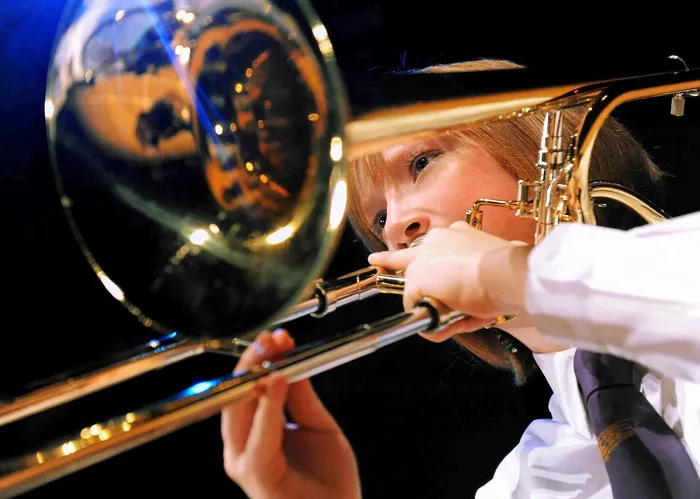The trombone and the saxophone are two iconic instruments that hold distinct places in the world of music. Both belong to the family of wind instruments, yet they possess unique characteristics that set them apart. Let’s delve into a brief introduction of these instruments before exploring which one might be harder to learn.
Introduction to Trombone and Saxophone
The trombone is a brass instrument characterized by its long slide and cylindrical bore. It produces sound by buzzing the lips into a mouthpiece while manipulating the slide to change the pitch. The trombone’s rich history dates back centuries, and its versatile sound is integral to various musical genres, from classical to jazz and beyond.
In contrast, the saxophone is a single-reed woodwind instrument invented by Adolphe Sax in the 1840s. Available in various sizes and pitches, the saxophone boasts a conical bore and a distinctive, powerful sound. Its versatility has made it a staple in jazz, classical, and contemporary music alike.
Trombone vs Saxophone, Which is Harder to Learn?
Alto Saxophone
For beginners, the alto saxophone often proves to be a more accessible choice. Its design and mechanics make it simpler to produce a sound compared to the trombone. With a single reed mouthpiece and a straightforward fingering system, aspiring saxophonists can quickly grasp the basics.
Moreover, the alto saxophone’s ergonomic design includes a neck strap that provides support, reducing the strain on the player’s arms and shoulders. This feature not only enhances comfort but also facilitates longer practice sessions without fatigue.
Trombone
On the other hand, learning the trombone presents several challenges that may deter novice musicians. One of the primary difficulties lies in mastering the slide positions. Unlike keyed instruments where pressing a specific key reliably produces a note, the trombone requires precise slide movements to achieve accurate pitches. This demands coordination, dexterity, and a keen ear for intonation.
Additionally, achieving the correct embouchure (the positioning and shaping of the lips and facial muscles) is crucial for producing a clear tone on the trombone. Beginners often struggle to find the right balance of air pressure and lip tension, leading to inconsistent sound production.
Breath control is another fundamental aspect of trombone playing that requires diligent practice. Sustaining long phrases and executing dynamic variations necessitate efficient air management, which can be challenging for beginners to master.
In summary, while both instruments require dedication and practice to excel, the trombone’s unique mechanics and technical demands may make it a more daunting instrument for beginners.
SEE ALSO: Is a Trombone Harder than a Guitar?
Cost and Maintenance
Saxophone
When considering the financial aspect, saxophones tend to be pricier than trombones. This higher cost is attributed to factors such as materials, craftsmanship, and demand. Additionally, saxophones require regular maintenance to ensure optimal performance. This includes replacing reeds, adjusting pads, and periodic cleaning to prevent buildup of moisture and debris.
Trombone
In contrast, trombones offer a more cost-effective option for aspiring musicians. While there are high-end models available, entry-level trombones are generally more affordable than saxophones of comparable quality. Furthermore, trombones have fewer moving parts, reducing the likelihood of mechanical issues and simplifying maintenance requirements.
With fewer components to maintain and replace, trombonists can focus more on honing their skills without the added financial burden of frequent repairs and upkeep.
Physical Considerations
Saxophone
Physically, the saxophone’s weight is primarily supported by a neck strap, which distributes the instrument’s load across the player’s neck and shoulders. This design minimizes strain on the arms and hands, allowing for greater comfort during extended playing sessions.
Additionally, the saxophone’s ergonomic design promotes proper posture and hand positioning, facilitating ease of play and reducing the risk of fatigue-related injuries.
Trombone
In contrast, the trombone’s weight is distributed differently, with the majority of the instrument’s mass concentrated in the player’s hands. Holding the trombone upright for prolonged periods can be physically demanding, especially for younger or smaller individuals with less upper body strength.
Moreover, reaching the various slide positions requires stretching and maneuvering the arms, which can pose challenges for players with limited reach or mobility. While adjustable features such as hand rests and counterweights exist to alleviate strain, mastering the physical demands of the trombone may require additional effort and conditioning.
Sound and Musical Styles
Saxophone
One of the saxophone’s greatest strengths lies in its versatility across a wide range of musical genres. From the smooth melodies of jazz to the soaring solos of classical music and the infectious riffs of pop and rock, the saxophone’s expressive capabilities make it a favorite among musicians and audiences alike.
Its ability to convey emotion and nuance through tone color, articulation, and phrasing has cemented its place as a quintessential instrument in both solo and ensemble settings.
Trombone
While perhaps not as ubiquitous as the saxophone, the trombone possesses a unique sonic character that is unmistakable in its own right. In genres such as jazz and brass band music, the trombone’s rich, brassy timbre adds depth and warmth to ensemble textures.
One of the trombone’s signature techniques is the slide glissando, where players smoothly transition between pitches by extending or contracting the slide. This expressive tool allows trombonists to create sweeping, emotive gestures that punctuate musical phrases with flair.
Additionally, the trombone’s powerful sound makes it well-suited for dynamic, fortissimo passages, adding weight and intensity to ensemble performances.
SEE ALSO: Trumpet or Trombone, Which is Easier?
Personal Preference and Goals
Ultimately, the choice between learning the trombone or saxophone boils down to personal preference and musical goals. While the saxophone may offer a gentler learning curve and greater versatility, the trombone rewards dedicated players with its unique sound and expressive potential.
Conclusion
Whether drawn to the soulful melodies of the saxophone or the bold, brassy tones of the trombone, aspiring musicians are encouraged to explore both instruments and discover which resonates most deeply with their musical aspirations. With passion, perseverance, and practice, mastery of either instrument is within reach, offering a lifetime of musical fulfillment and artistic expression.


